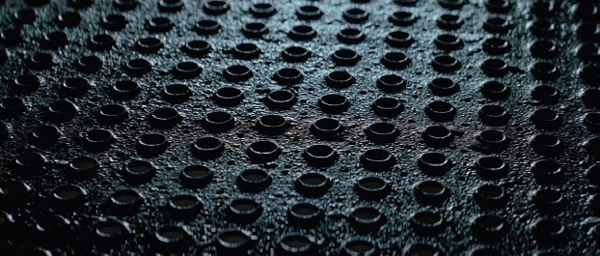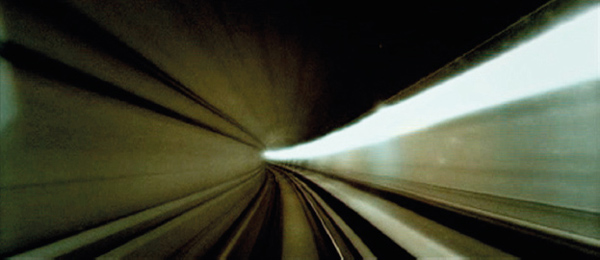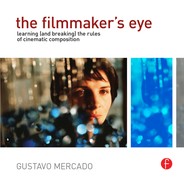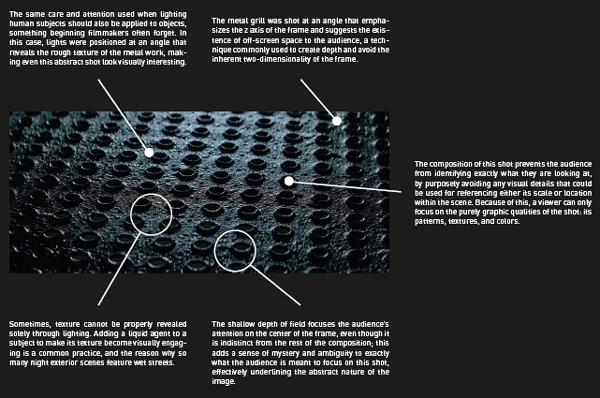abstract shot
The abstract shot originated in early avant-garde and experimental films from the 1920s; although initially they were used exclusively in these kinds of films, they were eventually incorporated in mainstream narrative films (a famous example being the “Stargate” sequence in Kubrick’s 2001: A Space Odyssey). These shots emphasize colors, textures, patterns, shapes, lines, and composition over their literal content. They are usually non-representational and non-referential, making it difficult or sometimes even impossible to recognize the subject of their compositions. Because of their abstract nature, audiences tend to extract meaning from these shots based on the raw emotional connection the graphic qualities of the image suggest, not unlike the associations conjured after looking at the inkblots of a Rorschach test. Sometimes, abstract shots have a subject that is partially recognizable but is somehow distorted or abstractly presented in some way, resulting in an image that is simultaneously familiar and foreign. Abstract shots are also created by showing a fragmented aspect of a subject, isolating a visual detail in a way that makes it difficult to identify without seeing it in a wider view. Because these shots are by design visually striking, they can be especially useful as part of the image system of a film. These shots are commonly used to convey subtextual ideas that are not explicitly addressed, but are instead suggested by the graphic qualities of the image itself. Because of this, abstract shots can add extra layers of meaning to a narrative, sometimes commenting on the action of a scene, the intentions of a character, or simply contributing to a recurring visual theme or motif that somehow feeds into the larger canvas of your story. The length of time an abstract shot (or a group of them) is kept on the screen should be carefully planned, because their appearance normally has the effect of bringing a stop to the conventional flow of a narrative. When seeing an abstract shot, audiences have to become active rather than passive observers if they are to understand how and why that shot connects with the rest of the story; if this is done too often or for too long, there is a possibility their investment with the characters will wane, but this of course depends on how well the abstract shots are integrated into the fabric of the story.
A good example of an abstract shot occurs in Joe Wright’s The Soloist (2009), a film that follows the relationship that develops between a journalist for the L. A. Times, Steve Lopez (Robert Downey Jr.) and Nathaniel (Jamie Foxx), a musically gifted homeless man who suffers from schizophrenia. After Lopez takes an interest in Nathaniel’s well-being, he brings him to a Los Angeles Symphony Orchestra rehearsal, where we are shown a series of abstract shots of colored lights as Nathaniel listens to the music. The idea behind these shots is not that he experiences music as flashing lights, but to convey an abstract sense of his deep and complex connection with rhythm, harmony, and melody that cannot be conveyed with more literal, representational imagery.
Joe Wright’s The Soloist (2009) contains scenes that use abstract shots to visualize the subjectivity of Nathaniel, a musically gifted homeless man (Jamie Foxx), when he experiences a musical performance. The abstract shots (reminiscent of the “Stargate” sequence in Kubrick’s 2001: A Space Odyssey) suggest the uniqueness of his connection to music.
abstract shot

why it works
Terrence Malick’s The Thin Red Line (1998), a poetic examination of war and its effect on the lives of the soldiers who fight it, contains several instances where the narrative takes a detour to concentrate on seemingly irrelevant visual details. These highly stylized shots usually concentrate on an aspect of the location where the action of the scene happens. In this example, the abstract shot is cut in the middle of a conversation between Witt (Jim Caviezel) and Hoke (Will Wallace) after they are caught AWOL and thrown in a brig. As Witt ponders his future, he momentarily focuses on the subject of the shot shown above, prompting him to reminisce about his childhood. We are never shown what the subject of this shot is, but its graphic qualities can be interpreted as evoking conformity (by the repeating pattern), the inorganic (when compared to similar shots used in other scenes that showcase plants and animals), and the military (by the greenish metal texture), all recurrent motifs examined in the philosophical narrative of this film.
technical considerations
lenses
Abstract shots can be created using various techniques that can include a combination of lenses, filtration, special lighting, and even post-production processes. Often, abstract shots are just extreme close ups that magnify a small detail (sometimes with the use of a macro lens) of a subject to such degree as to make it virtually unrecognizable. Another way to create abstract shots is by purposely adding some visual distortion to the subject; the easiest way to do this is by using the lens blur that happens when an object is out of focus, although specialized lenses like split field diopters and tilt-shift lenses can also be used, depending on the level of distortion desired (since these lenses allow you to selectively control the focusing range over a section of the image). Alternatively, abstract shots sometimes emphasize patterns or lines present in the subject that might have to be in focus for their associated meaning to come across. In this case, the natural distortion (or lack thereof) resulting from the use of wide angle, normal, and telephoto lenses should be taken into account and used accordingly.
format
Regardless of the format, any camera-oriented variable or adjustable setting is fair game to create abstract shots. The more you are familiar with the technical capabilities of your camera, the more options you will have to push the limits of the stylistic envelop. Shooting on film lets you shoot at frame rates that are slower or faster than the normal sync speed of 24 fps (25 fps in Europe), which in some cases can be used to create abstract shots. Undercranking, or shooting at frame rates slower than the norm, results in fast motion when played back at regular speed; combined with an open shutter (available only if your camera has a variable shutter function) can produce a motion blur effect, especially if the subject of the shot includes a lot of movement (like the example from Reconstruction on the next page). If the undercranking requires even slower frame rates than those available in your camera, it is also possible to use an intervalometer (a device that lets you shoot at intervals of several seconds or even minutes per frame), but be aware that not all film cameras are equipped to be controlled this way. It is also important to remember that undercranking causes more light reach the film, especially when combined with an open shutter, so exposure compensation is essential. If shooting HD, the option to shoot at lower frame rates is only available in some prosumer and higher-end cameras, although it would be possible, for instance, to shoot this footage with a still digital camera as still images to then combine them by importing every frame into an editing program (laborious, but possible, especially if the shot does not need to be too lengthy in duration). Most NLE (non-linear editing) systems have all kinds of video effects that can be used to distort images, but if you shoot on film and plan to finish on film, these effects will have to be scanned from the video files you output (assuming their resolution is acceptable to you; otherwise, they will have to be recreated at a much higher resolution) and transferred to a negative so that they can be incorporated into the final cut of your film, which can be an expensive proposition.
lighting
Some abstract shots are made entirely of light patterns that can be created from scratch by the filmmaker or found “as is” at a location (for example, a commonly used abstract shot consists of out-of-focus car headlights shot at night with a telephoto lens). Lighting can also be used to distort an image by purposely adding flares, done by simply aiming lights toward the lens. If the abstract shot is meant to showcase the texture of a subject, lighting can be used to reveal or conceal it, as needed (as seen in the example on the previous page).
breaking the rules

The narrative of Christoffer Boe’s Reconstruction (2003) follows the strange events that happen after Alex (Nikolaj Lie Kaas) leaves his girlfriend Simone (Maria Bonnevie) for Aimee (also played by Maria Bonnevie), seemingly causing an alternate reality to be created where none of his previous acquaintances recognizes him. The film has several abstract shots interspersed throughout the story, like the one above, an undercranked shot of a subway tunnel shown when Alex leaves his girlfriend on a train to pursue Aimee. Unlike most abstract shots, in this case we can easily recognize the source of the image, but the stylization created by shooting at a lower frame rate, combined with creative sound design, manages to make the audience concentrate on the shape, color, and texture of the image and the sci-fi concepts it evokes (a wormhole? A tunnel to an alternate universe?) rather than the actual content of the shot.
Requiem for a Dream. Darren Aronofsky, 2000.


